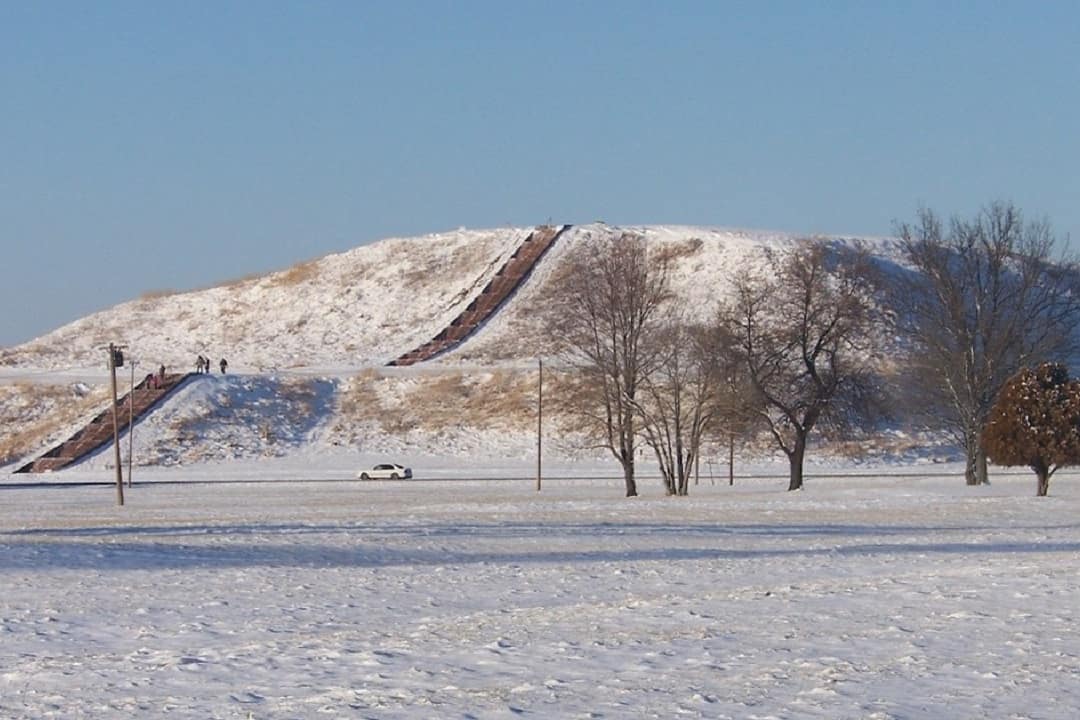Story Highlights:
- Five winter hiking destinations near St. Louis
- Top trails for winter hikes
- Basic winter hiking tips
Winter is one of the best times to hike in Missouri. Yes, you read that right: winter. When the trees lose their leaves, big new views open up to the brave hikers who face the chill. There’s no need to worry about tick bites or heat exhaustion. And when those mild, sunny days hit, there’s no better place to be than on a trail in the woods getting some fresh air.
A couple words of warning: even on cold or cloudy days, the sun’s rays can still damage your skin, so remember hat and sunscreen. And though you’re not sweating much or at all, you still need to hydrate, so throw a bottle of water in your backpack with your first aid kit and extra layers.
Cahokia Mounds State Historic Site (pictured, top) is famous as the site of one of the greatest pre-colonization cities in the Americas. Many of the mounds near Collinsville, Illinois, are preserved, and some of the structures have been recreated to show visitors how the Cahokia people used and protected the ceremonial sites. Roughly 20 miles of trails wend through the grounds. It’s ideal in winter because most of the hikes are shadeless. Take your time exploring the sites of the palisade walls, Woodhenge calendar, and Monks Mound, the largest manmade earthen mound in North America. Monks Mound is about 100 feet high, and there are 150 steps that lead to the top for dramatic views of the St. Louis skyline, the Mississippi River, and the surrounding plains.
West Tyson Park is packed with hardwood forest that is hauntingly beautiful in winter. Though it’s minutes from Interstate 44 near Eureka, Missouri, the tree-covered hills seem to roll away into infinity as the trail meanders along ridges and through valleys. The Flint Quarry Trail leads past intriguing cliffs and is so named because the Osage and other tribes mined flint for their weapons and tools here. In fact, all of the flint artifacts found at Cahokia, 40 miles east and across the Mississippi, can be traced back to this site.

Pere Marquette State Park. (Great Rivers & Routes)
Pere Marquette State Park in Grafton, Illinois, is near the confluence of the Mississippi and Illinois rivers, making it a perfect spot to watch for bald eagles during their prime fishing season. Take the Goat Cliff Trail from the visitor center parking lot north and up the hill. The first half mile or so features lots of cool boulders and cliffs. With the trees off the leaves, you’ll get more and more views of the river and surrounding valleys the higher you climb. When you reach the trail junction, take a quick right to a shelter with viewing platforms. From here, you may actually find yourself above the soaring eagles. If the visitor center is open, check out the “eagle-cam”, which rangers will have trained on any nests they’ve found.
Pickle Springs Natural Area is an all-time favorite in the region, and for good reason. It’s Trail Through Time is jammed with fascinating sandstone formations, cliffs, boulders, box canyons, stream beds, and waterfalls. The loop is only a bit longer than two miles, but it will take you hours to complete if you check out every slot, hoodoo, and forest view. This hike is a treat year-round, but if you time your trip right, you can see spectacular ice falls. Try to go when it’s recently been well below freezing but not too snowy. Pickle Springs is more than hour south of St. Louis, near Ste. Genevieve, Missouri. If you want to make a day of it, Hawn State Park is right next door and has amazing trails along Pickle Creek and up on to the cliffs above for long views. To make it an overnight, reserve a site in the Hawn campground or walk about three-quarters of a mile to one of the backpacking sites.

Lone Elk Park in Eureka, Mo.
Lone Elk Park in Eureka is another all-time favorite — so much so that it had to be closed for a time at the start of the pandemic in spring 2020 because of overcrowding. The park is, of course, famous for the many elk that roam the woods. But it has a strange history: During World War II and the Korean War, the site was used to test and store ammunition. Between the wars, herds of elk and bison were established, but then eliminated in the 1950s. A lone elk was missed when the rest of the herds were evicted. In the 1960s, St. Louis County acquired the land and brought six elk from Yellowstone National Park to keep the lone elk company. The 3-mile loop is best enjoyed in the winter because spring and summer here can mean lots and lots of ticks.
Looking for even more winter hiking trails? Look at our sidebar story here.
Author: Kathy Schrenk is a regular contributor to Terrain Magazine.


Leave A Comment